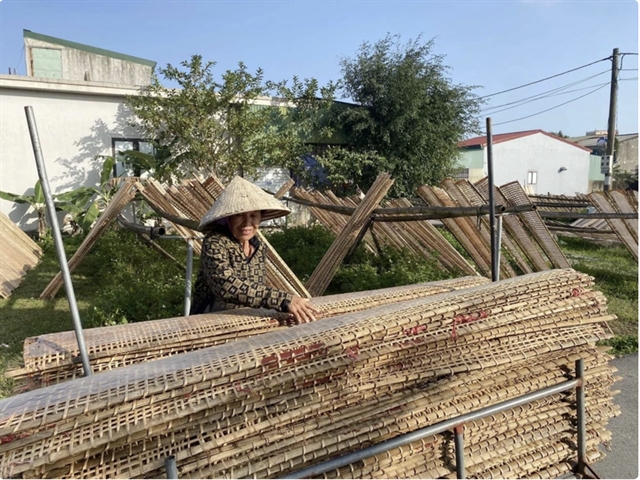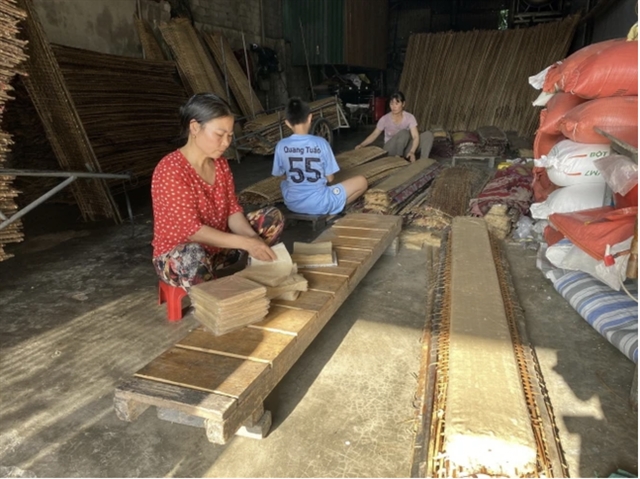 Society
Society

 |
| Rice papers are laid out to dry under the sun. VNA/VNS Photos |
HÀ NỘI – People in Hà Tĩnh Province's Bình Village, which is home to the traditional bánh đa nem (rice paper), are rushing to produce new batches of products to serve the increasing demand of customers for the Tết (Lunar New Year) holiday.
Production during the days leading up to Tết is doubled compared to normal days, following the spike in market demand.
This is considered the busiest and best time of the year for the people of the craft village to sell their products.
From 4am, the rice paper production facility of Lê Thị Dung's family begins to wake up with the sound of rice paper rolling machines and workers’ voices signalling a busy production day.
According to Dung, to have quality paper rice for making spring rolls, choosing the right type of rice is very important.
“Because the paper is made from 100 per cent rice, you must choose a clean, delicious type to make the best quality finished products that are soft and easy to roll, and give spring rolls a golden colour after frying,” said Dung.
"Normally, my facility uses about 300kg of rice every day, but in the month before Tết, the amount of rice ranges between 500-600kg per day. We also increase production into two shifts, morning and noon,” said Dung.
“On average, our facility produces nearly 90,000 papers a day," she added.
Having worked in this rice paper making business for more than 10 years, TrầnThị Thanh said rice papers need to be dried in the sun immediately after being steamed so that they can dry.
However, the drying time also depends on the outdoor temperature. If the sun is hot, the drying time will be shortened to ensure the papers do not become brittle or broken, Thanh said.
"During this time, my family has to hire more workers and mobilise family members to complete orders in time,” Thanh said.
At present, Bình Village in Thạch Hưng Commune has nearly 90 households producing rice paper, creating jobs for more than 200 local people.
Turnover of the craft is over VNĐ30 billion (US$1.2 million) a year.
 |
| Rice paper is processed and packaged. |
Lê Văn Vũ, head of Bình Village, said that previously, rice paper was made manually so productivity was low.
But in recent year, the producers have switched to using machines to increase productivity and make even higher quality products.
The craft brings a relatively stable income, so currently the village has nearly 85 per cent of households participating in the production, Vũ said.
This is also the main source of income for the villagers, he said.
The craft of rice paper making in Bình Village has a long tradition which is still preserved and promoted by the people there today.
In 2021, the People's Committee of Hà Tĩnh Province has decided to recognise and promulgate a plan to preserve and develop the traditional rice paper craft.
Chairman of the People's Committee of Thạch Hưng Commune, Trương Thế Kỷ, said that in recent years, rice paper production has created jobs and brought relatively high income to local workers.
In the coming time, to implement the plan of preserving and developing the craft villages approved by Hà Tĩnh Province, the commune will reorganise production to form value chains from raw material areas to production and product consumption.
The commune will also set up a trade promotion plan, develop raw material areas, build brands and geographical indications to create highly competitive products for the market, Kỷ said.
In particular, the commune will focus on building production and business processes to ensure food hygiene and safety and environmental protection, and work towards recognition as local OCOP (One Commune One Product) products, he said.
In addition, rice paper making craft village development is associated with local socio-economic development, promoting rapid transformation of rural economic structure towards urban economy. VNS